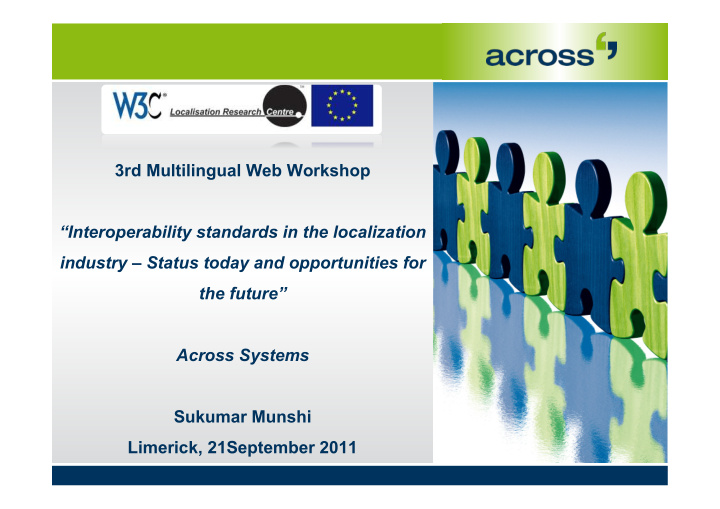



3rd Multilingual Web Workshop “Interoperability standards in the localization industry – Status today and opportunities for the future” Across Systems Sukumar Munshi Limerick, 21September 2011
Agenda > Introduction > Interoperability standards in the localization industry > Interoperability & perspectives > Options for the future, discussion points > Conclusions
“While the Localization industry matures, many views, perspectives, constraints and maturity issues are competing against each other when it comes to interoperability standards.“ „Interoperability is real when tools can seamlessly process files and interpret their content with no significant data loss.“ „The wealth interoperability can bring to localization remains an untapped potential, as many factors of a successful standard introduction are not taken into account.“
Definitions of Interoperability > IEEE Glossary: the ability of two or more systems or components to exchange information and to use the information that has been exchanged. > WIKIPEDIA: Interoperability is a property of a product or system, whose interfaces are completely understood, to work with other products or systems, present or future, without any restricted access or implementation.
Aspects of Interoperability > Data management > Technology usage Business Technology > Process Benefits > Business purpose Interoperability > Regulatory aspects Process Data Regulations
Interoperability – who cares / who should > Customers } Software Vendors More flexibility onboarding new } Create less parsers solutions } Concentrate on the core product Freedom of choice > Language Service Providers } Organizations Securing investments in current } Interoperability matters to the software industry Less pre- /post processing Flexibility with suppliers } Governmental institutions } Economical concerns
Interoperability Standards in Localization Common Denominator TMX 1.4b 2005 Adoption rate Applicability ITS 1.0 2007 Depth of Business implementation Relevance GMX-V 1.0 2007 Version support Enhanced Version TBX / ISO 30042 2008 Collaboration Deprecated Training SRX 2.0 2008 Certification XLIFF 1.2 2008 Awareness
From Standard to Maturity Ubiquity TMX TBX Historical or Not widely used Maturity SRX ITS XLIFF Released Translation WS GMX-V Standards in „spe“ XML:TM Open Tag OLIF SOAP/ XPATH XSLT Technology application WSDL XML ISO 3166 SGML Base Standards ISO 639-1 UNICODE
Interoperability Issues (XLIFF Other) Connectivity Match > Data set divergence > Process and practice diversity File Format Compatibility > Implementation depth and quality Data Accessibility > Tool to tool interoperability > Process relevance Metadata Interpretation Common Data Set Agreed Practice Standardized Behavior
The benefits and cost of interoperability Benefits Caveats Invest in precursors 1. 1. Prevent being locked-in of standards 2. Repurpose data Mix innovation with standard 2. 3. Avoid costly pre-post processing application 4. Concentrate on core task 5. Improve process efficiency Not invest at all 3. Standardize and inflate, while 4. disconnecting from the beneficiaries Make a poor implementation 5.
Examples from other industries (1/2) } Cable providers felt locked-in to > DOCSIS – Data over Cable Service Interface proprietary technology Specification } Motivation to promote > EDI - Electronic Data Interchange interoperability standards } Price of $500 per modem in 1994 > HL7 – Health Level 7 } Introduction of DOCSIS by CableLabs – Certification Program } In 2005 Price fell $40
Examples from other industries (2/2) } One of the NIST studies estimates > (Brunnermeier et al, 1999 and White et that lack of interoperability led to a al, 2004) - estimates of cost for the US cost of US$ 15.8 billion to the US economy, arising from lack of governmental infrastructure capital interoperability: investments, i.e. on all governmental building and US$1 billion/year: engineering data in construction infrastructures. automotive US$5 billion/year: all supply chain data in automotive industry } Excess of that amount in public US$3.9 billion/year: all supply chain money and therefore taxpayers’ data in electronics industry. contributions (Gallagher et al, 2004).
Organizations and interest in interoperability The Gala Standards Initiative > ISO TC 37 > ETSI > The industry does not suffer from lack of > W3C standards, more from lack of awareness > OASIS > Standards may not be in sync with evolving > GALA requirements > TAUS > Standards relevant to the industry are developed by many bodies > EU > Lack of training, promotion and best > Unicode Consortium practices about localization standards > OMG > SAE > Initiative to collaborate and facilitate work > SIG on standards, bring together disparate constituencies that are impacted by standards > [LISA]
The future of Interoperability By 2015 … > The pressure on interoperability has increased due to cloud based processing. > The community of organisations, customers, suppliers and tool vendors will fully endorse supporting standards > All interested parties will have agreed on how IO standards should be applied > Tools will support the basic concepts of all current IO standards > Added value will be on performance, throughput and solutions for specific applications of the standards
Conclusions > A released specification does not make a standard successful. > Standard generation and adoption is an immature process in the localization industry (or it just needs time). > A successful standard is widely used in the industry and delivers benefits to all the interest groups involved. > As the localization industry is progressing, pressure increases, the visibility of challenges in the industry and the need for standards is growing.
Fragen & Antworten
Recommend
More recommend